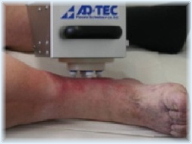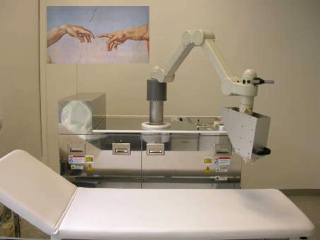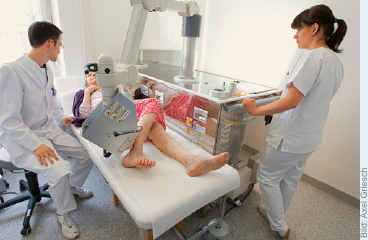| |
|
|
|
|
|
|
Plasma Medicine

 Back to Plasma Medicine
Back to Plasma Medicine
2. Klinik für Dermatologie, Allergologie und Umweltmedizin, Klinikum
Schwabing, München, Germany
In collaboration with the Max Planck Institute for Extraterrestrial Physics,
Garching, and ADTEC Plasma Technology Co. Ltd, Hiroshima the Department of
Dermatology, Allergology and Environmental Medicine, Hospital Munich Schwabing
started to treat patients with chronic infected wounds using a low temperature
argon plasma to decrease the bacterial load on these wounds to achieve a faster
wound healing. This phase II study – the first worldwide – began in
October 2005
after finishing the phase I study, which proved the efficacy and safety of the
treatment and obtained the agreement of the ethics committee.
Because of its physical properties plasma has a bactericidal effect due to
reactive species, charging, UV and heat. This is the reason why the use of
plasmas in medicine is already established, e.g. for the sterilization of
surfaces or medical equipments in vacuum or for the coagulation of intraoperative
bleedings with hot plasma (>80°C). The plasma torch used for the studies
produces a low temperature (<40°C) Argon plasma at atmospheric conditions.
This new technical development in the area of ''cold atmospheric plasmas'' allows
in-vivo applications, such as the treatment of infected wounds or normal skin.
Infectious skin diseases caused by bacteria are one of the main reasons for
hospitalization of patients, causing costs of billions of Euro each year.
Leading among them are infections of wounds like chronic ulcers of the lower leg,
which are also a major reservoir for multiresistant bacterial strains. Standard
treatments for these wounds include topical and systemic antibacterial regimens,
but are often limited by the development of resistance of germs against
antibiotics or by allergic reactions. Having a temperature just slightly above
body temperature and presenting a contact free application for ''rough'' surfaces
down to micrometer scale, Argon plasma can be easily applied on wounds.
Furthermore, because of the properties of a physical therapy, resistance of
germs or allergic reactions due to plasma is less feasible. All these properties
fit perfectly to treat chronic infected wounds in terms of resistance.
The MicroPlaSter Alpha – a system built and tested by ADTEC Plasma
Technology Co. Ltd., Hiroshima / London – is used once or even twice a
day on both in- and out-patients included to the clinical trial. These patients
receive standard wound care besides a 2 to 5 min plasma treatment on randomized
wound(s). After well over 150 patients we found a significant higher germ
reduction in plasma treated wounds compared to the control wounds in an interim
analysis. This reduction is found for all kinds of germs, even multiresistant
ones like MRSA as proven in a preceding phase I. Furthermore the treatment
itself is very well tolerated in almost all cases without possessing any side
effects yet. Since 2009 the MicroPlaSter Alpha was replaced by the
MicroPlaSter Beta, which is now used for the plasma treatment of patients.


Figures: Left: MicroPlaSter Alpha; Right: Treatment of a patient
Read more
- from the team in Regensburg
|
|
|
|
| |
|
|

